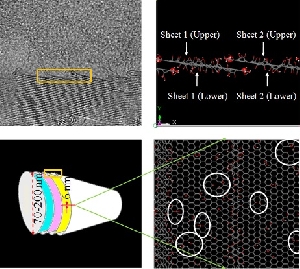CCS Publication Abstract
Molecular Dynamics Simulations of Oxidized Vapor-grown Carbon Nanofiber Surface Interactions with Vinyl Ester Resin Monomers
Jang, C., Nouranian, S., Lacy, T., Gwaltney, S. R., Toghiani, H., & Pittman, C. (2012). Molecular Dynamics Simulations of Oxidized Vapor-grown Carbon Nanofiber Surface Interactions with Vinyl Ester Resin Monomers. Carbon. 50(3), 748-760. DOI:10.1016/j.carbon.2011.09.013.
Abstract
Surface oxidation effects on the liquid vinyl ester (VE) monomer distributions near two oxidized vapor-grown carbon nanofiber (VGCNF) surfaces were studied using molecular dynamics simulations. Two overlapping graphene sheets containing oxygenated functions represented the oxidized VGCNF surfaces. Two liquid VE bisphenol-A dimethacrylates (designated VE1 and VE2, respectively) and styrene constituted the resin. Temporally and spatially averaged relative monomer concentrations, calculated in a direction away from the oxidized graphene surfaces, showed increased styrene and VE1 concentrations. Monomer molar ratios found within a 10 Å thick region adjacent to the oxidized graphene sheets were substantially different from those of the bulk resin. Curing should result in the formation of a very thin interphase region of different composition. The crosslink structure of such an interphase will be distinct from that of an unoxidized VGCNF surface. The enhanced VE1 concentration near this oxidized surface should give a higher crosslink density, leading to a stiffer interphase than that adjacent to unoxidized VGCNF surfaces. VGCNF-matrix adhesion may also be modified by the different interphase monomer molar ratios. These studies may facilitate multiscale material design by providing insight into carbon nanofiber-matrix interactions leading to improved macroscale composite properties.

